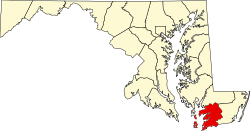Tylerton, Maryland | |
|---|---|
| Coordinates: 37°58′04″N76°01′23″W / 37.96778°N 76.02306°W | |
| Country | |
| State | |
| County | |
| Elevation | 1 m (3 ft) |
| Time zone | UTC-5 (Eastern (EST)) |
| • Summer (DST) | UTC-4 (EDT) |
| ZIP code | 21866 |
| Area codes | 410, 443, and 667 |
| GNIS feature ID | 591450 [1] |
Tylerton is an unincorporated community located on Smith Island in Somerset County, Maryland, United States. [1] Tylerton can be accessed via a ferry from Crisfield, Maryland. It is a waterman village of 50 residents. Attractions in the community include the Inn of Silent Music and The Drum Point Market, which sells beverages, homemade Smith Island cakes, crab cakes and other Chesapeake Bay specialties. The Chesapeake Bay Foundation's Smith Island Study Center is located in Tylerton. It is the southernmost community in Maryland.

